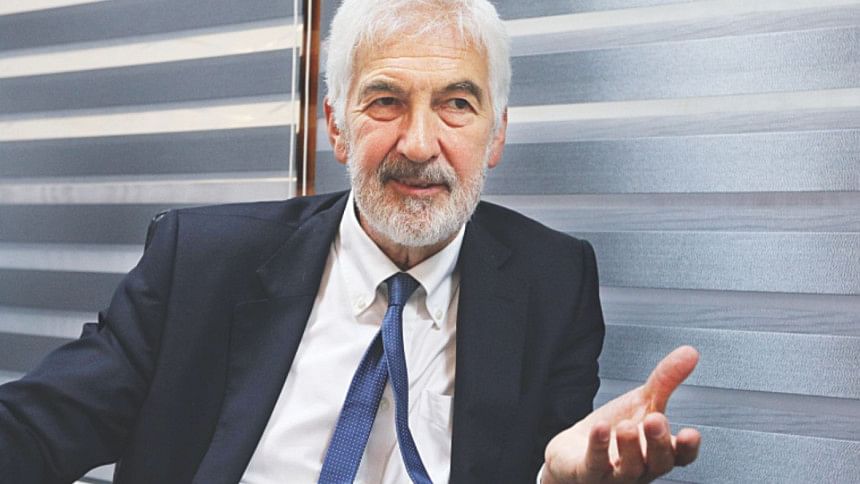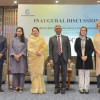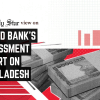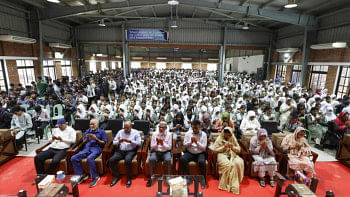Congested Dhaka city needs more space

Development of the eastern part of Dhaka would help reduce population density and traffic congestion in the entire city, allowing it to stay vibrant and be more productive for a rapid economic growth.
“East Dhaka project will obviously create housing, jobs and increase the total area of the city… it will take pressure off the existing city,” Prof Anthony Venables of University of Oxford's Economics department told The Daily Star in an interview on Thursday.
Venables, who has published extensive works in the fields of international trade and spatial economics, and economic geography, was in the capital last week to attend a conference on development options for Dhaka towards 2035.
The World Bank organised the event where he presented a paper on the city's possible scenario by that year. The paper was authored by professor Venables and three other researchers.
Venables said Dhaka “is amazingly a vibrant city. But it is also a messy city. It needs to have more space. And eastern Dhaka is certainly an opportunity to get more urban space”.
According to the WB, Dhaka's urbanisation originated along the northern corridor of the central region, and then expanded westward. Its eastern half is mostly rural but has the potential to develop rapidly.
Accounting for 40 percent of the city's surface, the eastern half has the advantage of being within 5kms of prosperous areas like Gulshan, which can help support its growth through capital and human resource investments.
Speaking at the same conference, WB Chief Economist for South Asia Martin Rama said out of the 16 union parishad areas added to Dhaka city, 12 were on the eastern fringe and could accommodate a new city.
In his paper, Venables presented four simulation scenarios of Dhaka by 2035, depending on the actions that are being taken today.
These scenarios depended on businesses, construction of flood barrier on the eastern part, building of embankments along with investments in building transport infrastructure, and amenities in eastern Dhaka.
Venables and his colleagues found that construction of a flood barrier in eastern Dhaka would directly have a substantial impact on the Gross Value Added, which is a measure of the value of goods and services produced in an area, industry or sector.
But the development would be “informal residential and manufacturing, without further simultaneous strategies”.
Adding extra roads and public transits would reduce traffic congestion, increasing connectivity to eastern Dhaka and improving communication throughout the rest of the city, Venables said.
He also said: “…if the government builds the dyke [on the eastern Dhaka], it has to make sure that planned development also takes place inside the area. There will be enormous appreciation of land values if it is developed.”
The government also has to make sure it has a way of capturing the increasing values that would be used to finance the needed infrastructure, he said.
“Land can be taxed. Land use can be regulated. Development corporations can be set up to acquire areas of land for development. And that can be done by the state, by the government,” said Venables, also a fellow of British Academy and of the Econometric Society.
Currently, Dhaka is suffering from extreme congestion and having problems in supply of amenities and many dwellers fear that the city might be unlivable unless proper infrastructure is put in place.
Today, traffic congestion eats up around 3.2 million working hours every day and costs the economy several billion dollars every year. Average driving speed on Dhaka city streets has dropped by one third-- from 21kmph a decade ago to 7kmph.
Continuing on current trends would result in a further slowdown to 4 kmph, which is slower than walking speed, according to a WB estimate.
Despite such shortcomings, greater Dhaka, which accounts for 20 percent of Bangladesh's GDP, still attracts people from across the country for livelihoods, because of expansion of businesses and industrial activities over the years.
Venables said Dhaka creates a lot of jobs owing to the economic activities. But the quality of the infrastructure is not better than that of in China and other Asian cities.
“The city [Dhaka] is productive but it is not productive as it should be. I think, the real thing missing here is other public assets -- infrastructure, transport and ability to move around the city.”
The second thing is lack of land for a well planned urban expansion, he said, suggesting policymakers to try to create additional urban space.
“Overall, urban population of Bangladesh is going to increase enormously in the coming years. So, a part of that will take place in Dhaka.”
Dhaka's population is expected to double to 3.5 crore by the year 2035 from the 1.8 crore at present, according to the WB.
“Cities will continue to grow. The urban population share of cities in the total population will continue to increase as well. That is going to happen because cities are where job opportunities are,” said Venables, who was also the chief economist at the UK Department for International Development.
“I think what you got to do is to do a diagnosis of what is holding cities back. You would expect a second city in the country to be quite a lot larger than Chittagong city. So, the second, third and fourth cities will seem a bit too small. It is important for those cities to grow fast,” added the professor.

 For all latest news, follow The Daily Star's Google News channel.
For all latest news, follow The Daily Star's Google News channel. 








Comments